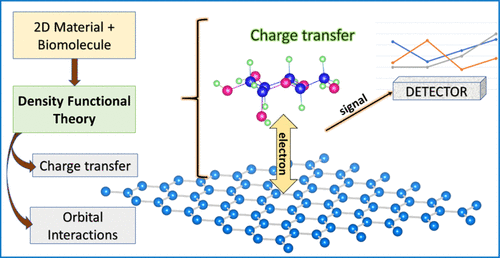当前位置:
X-MOL 学术
›
J. Phys. Chem. B
›
论文详情
Our official English website, www.x-mol.net, welcomes your
feedback! (Note: you will need to create a separate account there.)
Theoretical Insight on the Biosensing Applications of 2D Materials
The Journal of Physical Chemistry B ( IF 2.8 ) Pub Date : 2020-11-24 , DOI: 10.1021/acs.jpcb.0c08539 Antara Vaidyanathan 1 , Minu Mathew 2 , Sithara Radhakrishnan 2 , Chandra Sekhar Rout 2 , Brahmananda Chakraborty 3, 4
The Journal of Physical Chemistry B ( IF 2.8 ) Pub Date : 2020-11-24 , DOI: 10.1021/acs.jpcb.0c08539 Antara Vaidyanathan 1 , Minu Mathew 2 , Sithara Radhakrishnan 2 , Chandra Sekhar Rout 2 , Brahmananda Chakraborty 3, 4
Affiliation

|
The research on the design of efficient, reliable, and cost-effective biosensors is expanding given its high demand in various fields such as health care, environmental surveillance, agriculture, diagnostics, industries, and so forth. In the last decade, various fascinating and interesting 2D materials with extraordinary properties have been experimentally synthesized and theoretically predicted. 2D materials have been explored for the sensing of different biomolecules because of their large surface area and strong interaction with different biomolecules. Theoretical simulations can bring important insight on the interaction of biomolecules on 2D materials, charge transfer, orbital interactions, and so forth and may play an important role in the development of efficient biosensors. Quantum simulation techniques, such as density functional theory (DFT), are very powerful and are gaining popularity especially with the advent of high-speed computing facilities. This review article provides theoretical insight regarding the interaction of various biomolecules on different 2D materials and the charge transfer between the biomolecules and 2D materials leading to electrochemical signals, which can then provide experimentalists the useful design parameters for fabrication of biosensors. It also includes an overview of quantum simulations, use of the DFT method for simulating biomolecules on 2D materials, parameters obtained from theoretical simulations and sensitivity, and limitations of computational techniques for sensing biomolecules on 2D materials. Furthermore, this review summarizes the recent work in first-principles investigation of 2D materials for the purpose of biomolecule sensing. Beyond the traditional graphene or 2D transition-metal dichalcogenides, some novel and recently proposed 2D materials such as pentagraphene, haeckelite, MXenes, and so forth which have exhibited good sensing applications have also been highlighted.
中文翻译:

二维材料生物传感应用的理论见解
鉴于在医疗保健,环境监测,农业,诊断,工业等各个领域的高需求,对有效,可靠和具有成本效益的生物传感器设计的研究正在扩展。在过去的十年中,已通过实验合成并从理论上预测了各种具有非凡性能的有趣且有趣的2D材料。由于二维材料具有较大的表面积以及与不同生物分子的强相互作用,因此已经探索了用于检测不同生物分子的材料。理论仿真可以为2D材料上生物分子的相互作用,电荷转移,轨道相互作用等带来重要的见解,并且在有效的生物传感器的开发中可能起重要作用。量子模拟技术 诸如密度泛函理论(DFT)之类的技术非常强大,并且随着高速计算设备的出现而越来越受欢迎。这篇综述文章提供了有关各种生物分子在不同2D材料上的相互作用以及生物分子和2D材料之间的电荷转移(导致电化学信号)的理论见解,从而可以为实验者提供制造生物传感器的有用设计参数。它还概述了量子模拟,使用DFT方法模拟2D材料上的生物分子,从理论模拟和灵敏度获得的参数以及用于感测2D材料上的生物分子的计算技术的局限性。此外,这篇综述总结了以生物分子传感为目的的二维材料第一性原理研究的最新工作。除了传统的石墨烯或2D过渡金属二硫属化合物以外,还突出了一些新颖且最近提出的2D材料,例如五石墨烯,方铁矿,MXenes等,这些材料已显示出良好的传感应用。
更新日期:2020-12-10
中文翻译:

二维材料生物传感应用的理论见解
鉴于在医疗保健,环境监测,农业,诊断,工业等各个领域的高需求,对有效,可靠和具有成本效益的生物传感器设计的研究正在扩展。在过去的十年中,已通过实验合成并从理论上预测了各种具有非凡性能的有趣且有趣的2D材料。由于二维材料具有较大的表面积以及与不同生物分子的强相互作用,因此已经探索了用于检测不同生物分子的材料。理论仿真可以为2D材料上生物分子的相互作用,电荷转移,轨道相互作用等带来重要的见解,并且在有效的生物传感器的开发中可能起重要作用。量子模拟技术 诸如密度泛函理论(DFT)之类的技术非常强大,并且随着高速计算设备的出现而越来越受欢迎。这篇综述文章提供了有关各种生物分子在不同2D材料上的相互作用以及生物分子和2D材料之间的电荷转移(导致电化学信号)的理论见解,从而可以为实验者提供制造生物传感器的有用设计参数。它还概述了量子模拟,使用DFT方法模拟2D材料上的生物分子,从理论模拟和灵敏度获得的参数以及用于感测2D材料上的生物分子的计算技术的局限性。此外,这篇综述总结了以生物分子传感为目的的二维材料第一性原理研究的最新工作。除了传统的石墨烯或2D过渡金属二硫属化合物以外,还突出了一些新颖且最近提出的2D材料,例如五石墨烯,方铁矿,MXenes等,这些材料已显示出良好的传感应用。











































 京公网安备 11010802027423号
京公网安备 11010802027423号